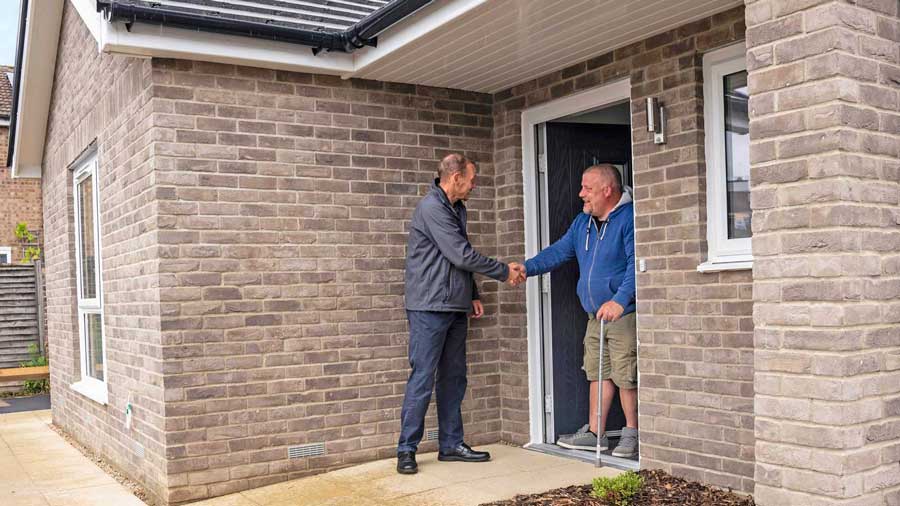A shared ownership apartment in Barratt London's Hendon Waterside development delivered with MTVH
Solving the Section 106 problem
A ‘Registered Provider of last resort’ to purchase homes from developers could unlock this key stream of affordable housing delivery

GROWTH, REGENERATION & DEVELOPMENT
Barratt London's Hendon Waterside development, delivered with Metropolitan Thames Valley Housing

Syreeta Robinson-Gayle
Head of Affordable Housing, Barratt London

Syreeta Robinson-Gayle
Head of Affordable Housing, Barratt London
Issue 73 | September 2024
The loss of appetite among housing providers to purchase homes from developers through the Section 106 process has been clearly set out in a recent report. This dramatic fall in activity acts as a collar on all development and restricts our ability to deliver the new homes we need in sustainable mixed communities. What is causing this and what can be done to address it?
A shared ownership apartment at the Hendon Waterside development
Squeezed finances
Housing associations have increased costs and reduced incomes. The social housing sector has faced increased operational costs due to inflation, decarbonisation, decent homes work for a new era and new fire safety arrangements. At the same time, housing providers have had their income restricted to help residents deal with the cost-of-living crisis.
Although acting on this income squeeze seems to be a priority of the new government, at the time of writing there is still no long-term rent settlement for social landlords – something the housing sector has been crying out for.
The response from housing providers to the alarm from developers about the reduced appetite for Section 106 housing has been to voice concerns about this mechanism in general. These concerns include:
- Lack of control over the delivery of the homes (both timing and specification)
- Perceived lack of quality
- High service charges
- Lack of responsiveness to residents’ concerns and repairs
of housing associations no longer intend to acquire Section 106 homes or are reducing their requirements
of housing associations reported that financial capacity had impacted appetite for Section 106 homes
of housing associations reported that financial capacity will remain a challenge for at least the next two to five years or longer
Source: Savills
Housing starts suffer
Developers need to listen to our delivery partners. However, even if all of these issues were resolved, housing providers would still have a reduced capacity and appetite for units. There is a shortfall between the number of Section 106 units that are due to be built and the capacity of the sector to absorb them. Smaller developers will reduce their exposure to the risk of having no off-ramp by restricting starts until a partner is secured or returning to local authority planning departments to instead agree commuted sums in lieu of affordable housing provision. With the high current levels of housing need this is a worst-case scenario.
In the short term we need an innovative response, while we have a new government full of hope we ask for direct investment in the form of a Registered Provider of last resort to take the Section 106 units that cannot be disposed of otherwise. For-Profit Registered Providers (FPRPs) have shown how small development teams can use the existing structures in the housing sector to take up large numbers of Section 106 allocations.
Registered Provider of last resort
Provide a Registered Provider of last resort to take social rented units – either sponsor one from the existing Registered Providers or use a government body to form one.
This will allow other housing providers to be selective, choosing only the sites that fit their own aspirations, but will also allow the delivery of large numbers of affordable homes that are desperately needed.
For example, there has long been a reluctance to take small numbers of units on a site – for housing associations these deals take as much resource to project manage as larger allocations. Yet there is no reason that sites with 20 or fewer affordable homes wouldn’t provide a great place to live for residents in need. A Registered Provider of last resort could operate regionally and mop up smaller sites before aggregating them to hand them over to either another housing association, FPRP or local authority.
If we are to have a chance of achieving the 1.5 million new homes in the lifetime of this parliament that the incoming government has promised, it will be all hands on deck. We need housing providers to deliver land-led schemes, developers to build out the planning consents they have and existing homes to be brought back into use. A working Section 106 delivery mechanism is a key part of delivering those new homes.
“A Registered Provider of last resort could operate regionally and mop up smaller sites before aggregating them to hand them over to either another housing association, FPRP or local authority.”

